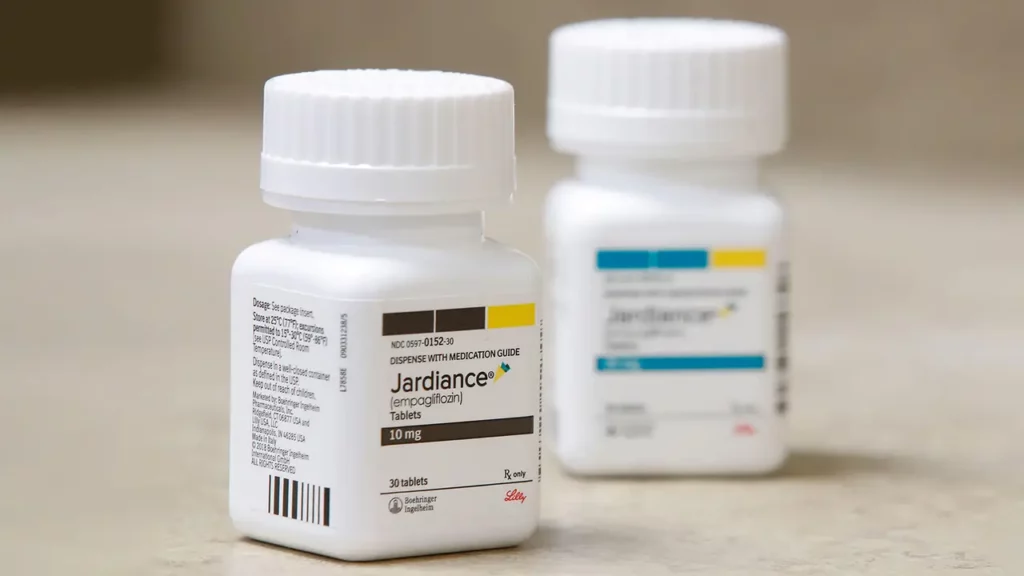In the ever-evolving landscape of diabetes treatment, Jardiance (empagliflozin) has emerged as a significant player. This blog aims to explore the groundbreaking possibilities that Jardiance injection could offer to individuals battling diabetes. We delve into the effectiveness, and the potential benefits and considerations of its use as an injection. Our goal is to provide a comprehensive understanding of this new development and how it is helpful in diabetes management.
Contents
Is Jardiance A Type Of Insulin?
 No, Jardiance (empagliflozin) is not a type of insulin. It belongs to a class of drugs known as sodium-glucose cotransporter 2 (SGLT2) inhibitors. These medications work in a unique way to manage blood sugar levels in people with type 2 diabetes. SGLT2 inhibitors like Jardiance function by preventing the kidneys from reabsorbing glucose back into the bloodstream. Instead, they allow excess glucose to be excreted in the urine.
No, Jardiance (empagliflozin) is not a type of insulin. It belongs to a class of drugs known as sodium-glucose cotransporter 2 (SGLT2) inhibitors. These medications work in a unique way to manage blood sugar levels in people with type 2 diabetes. SGLT2 inhibitors like Jardiance function by preventing the kidneys from reabsorbing glucose back into the bloodstream. Instead, they allow excess glucose to be excreted in the urine.
This process lowers blood glucose levels, but it does so in a manner that is entirely different from how insulin works. Insulin therapies, which are commonly used in diabetes treatment, involve administering insulin to the body to help in glucose uptake into cells, thereby reducing blood sugar levels. Unlike Jardiance, insulin does not cause excess glucose to be excreted in the urine. Rather, it aids in the metabolic process of glucose utilization by the body’s cells.
What Is Jardiance Injection Used For?
Jardiance (empagliflozin) is not available as an injection; it is an oral medication. Jardiance is a prescription medication used primarily for the management of type 2 diabetes. It belongs to a class of drugs called sodium-glucose cotransporter 2 (SGLT2) inhibitors. These drugs work by blocking the SGLT2 protein in the kidneys. This leads to the excretion of excess glucose through urine, thereby lowering blood sugar levels in individuals with type 2 diabetes.
In addition to its use in diabetes management, Jardiance has also been found to provide cardiovascular benefits. It is often prescribed to reduce the risk of cardiovascular death in adults with type 2 diabetes who have established cardiovascular disease. This added benefit makes it a valuable option in the comprehensive management of type 2 diabetes. Especially for patients with a higher risk of heart-related issues.
It’s important to note that medication forms and uses can evolve. So it’s always a good practice to consult with a healthcare provider or check the latest medical guidelines for the most current information.
What Are The Benefits Of Jardiance?
 Jardiance injection (empagliflozin) offers several benefits, particularly for individuals with type 2 diabetes and those at risk for heart disease. Its primary benefits include:
Jardiance injection (empagliflozin) offers several benefits, particularly for individuals with type 2 diabetes and those at risk for heart disease. Its primary benefits include:
Lowering Blood Sugar Levels
As a member of the SGLT2 inhibitor class of drugs, Jardiance works by helping the kidneys excrete excess glucose through the urine. This mechanism effectively lowers blood sugar levels in individuals with type 2 diabetes.
Cardiovascular Benefits
Clinical studies have shown that Jardiance can reduce the risk of cardiovascular death in people with type 2 diabetes who have established cardiovascular disease. This makes it not only a drug for glycemic control but also a part of cardiovascular risk management.
Weight Loss
Patients taking Jardiance may experience weight loss. The mechanism of action of Jardiance, which involves excreting excess glucose (and therefore calories) in the urine, can contribute to a reduction in body weight. This is particularly beneficial for diabetic patients as weight loss can further help in managing blood sugar levels and reducing the risk of cardiovascular diseases.
Blood Pressure Reduction
Jardiance can have a mild diuretic effect, leading to a reduction in blood pressure. This is beneficial for patients with hypertension or those at risk of high blood pressure.
Kidney Protection
Emerging evidence suggests that SGLT2 inhibitors like Jardiance can offer renal protective benefits. They may help in slowing the progression of kidney disease in patients with type 2 diabetes. This is important as diabetes is a major risk factor for chronic kidney disease.
Improved Glycemic Control without Hypoglycemia
Unlike some other diabetes medications, Jardiance typically does not cause hypoglycemia (low blood sugar) when used alone. This makes it a safer option, especially for patients who are at risk of hypoglycemia or have difficulty maintaining stable blood sugar levels.
Ease of Use
Being an oral medication, Jardiance is easy to take and can be conveniently integrated into a patient’s daily routine. It may improve adherence to the treatment plan.
It’s important to note that while Jardiance offers these benefits, it may not be suitable for everyone and can have side effects. Patients should consult with their healthcare provider to determine if Jardiance is the right medication for their individual health needs and conditions.
What Is The Success Rate Of Jardiance?
 The success rate of Jardiance (empagliflozin) in treating type 2 diabetes and reducing the risk of cardiovascular events has been substantiated through various clinical trials and studies. However, quantifying a specific “success rate” can be complex, as it depends on the particular outcomes being measured, such as blood sugar control, weight loss, cardiovascular risk reduction, or improvement in kidney function. Here are some key findings from research on Jardiance:
The success rate of Jardiance (empagliflozin) in treating type 2 diabetes and reducing the risk of cardiovascular events has been substantiated through various clinical trials and studies. However, quantifying a specific “success rate” can be complex, as it depends on the particular outcomes being measured, such as blood sugar control, weight loss, cardiovascular risk reduction, or improvement in kidney function. Here are some key findings from research on Jardiance:
- Blood Sugar Control: In clinical trials, Jardiance has been shown to effectively lower blood sugar levels, as measured by reductions in HbA1c (a marker of average blood glucose levels over the past 2-3 months). The percentage of patients achieving their target HbA1c levels varies among studies but is generally significant compared to placebo or other diabetes medications.
- Cardiovascular Benefits: The EMPA-REG OUTCOME trial, a landmark study, demonstrated that Jardiance significantly reduced the risk of cardiovascular death in patients with type 2 diabetes and established cardiovascular disease. The study showed a 38% reduction in the risk of cardiovascular death, a 35% reduction in hospitalization for heart failure, and a 32% reduction in all-cause mortality.
- Weight Loss and Blood Pressure Reduction: Patients taking Jardiance often experience modest weight loss and a reduction in blood pressure, contributing to overall health improvements, especially beneficial for patients with obesity or hypertension.
It’s important to note that individual responses to Jardiance can vary based on several factors, including the severity of diabetes, other health conditions, and adherence to the medication regimen. Moreover, Jardiance is most effective when combined with lifestyle modifications like diet and exercise and, in some cases, other diabetes medications.
Is Jardiance Better Than Metformin?
Comparing Jardiance (empagliflozin) with Metformin isn’t straightforward as they are different types of medications with distinct mechanisms of action and are often used together for synergistic effects in the management of type 2 diabetes.
Metformin, often the first-line treatment for type 2 diabetes, primarily works by decreasing glucose production in the liver and improving insulin sensitivity. Thus reducing blood glucose levels. It’s well-known for its effectiveness, safety profile, and additional benefits. Metformin is often preferred for newly diagnosed patients and is particularly beneficial for those who are overweight or obese.
Jardiance, a newer class of diabetes medication (SGLT2 inhibitor), works by causing excess glucose to be excreted in the urine. Thus lowering blood sugar levels. Unlike Metformin, Jardiance also offers significant cardiovascular benefits, especially in patients with existing heart disease, and it has shown renal protective effects. It may be preferred in patients with type 2 diabetes who have a higher risk of heart disease or chronic kidney disease.
However, Jardiance can be more expensive and has different side effects compared to Metformin. Hence, whether Jardiance is “better” than Metformin depends on individual patient factors and tolerance to each medication.
What Are The Side Effects of Oral Jardiance?
 Like any medication, Jardiance injection in its oral form does have potential side effects. It’s important to be aware of these, as they are relevant to patients considering this medication for type 2 diabetes. Common side effects of oral Jardiance include:
Like any medication, Jardiance injection in its oral form does have potential side effects. It’s important to be aware of these, as they are relevant to patients considering this medication for type 2 diabetes. Common side effects of oral Jardiance include:
- Urinary Tract Infections (UTIs) and Genital Infections: Since Jardiance works by excreting excess glucose in the urine, it can increase the risk of urinary tract and genital infections.
- Dehydration and Low Blood Pressure: The increased urination caused by Jardiance can lead to dehydration, particularly in elderly patients. It might result in low blood pressure.
- Ketoacidosis: Although rare, Jardiance can increase the risk of diabetic ketoacidosis, a serious condition where the body produces high levels of blood acids called ketones.
- Kidney Function Issues: While Jardiance has renal protective effects, it can also impact kidney function, especially in patients with pre-existing kidney disease or those taking other medications that affect kidney function.
- Hypoglycemia: When used in combination with insulin or insulin-stimulating drugs, Jardiance can increase the risk of hypoglycemia (low blood sugar).
- Fungal Infections: Genital yeast infections are more common, especially in women.
- Increased Cholesterol Levels: Some patients may experience a mild increase in LDL (bad) cholesterol levels.
- Bone Fracture Risk: There is some evidence suggesting an increased risk of bone fractures with SGLT2 inhibitors, including Jardiance.
It’s important for patients to discuss potential side effects with their healthcare provider. They can provide guidance based on their individual health status and treatment goals.
Conclusion
In conclusion, Jardiance injection represents a significant advancement in the treatment of type 2 diabetes, offering a novel approach to blood sugar control, along with additional benefits for heart health and potentially for kidney function. While it is different from traditional diabetes treatments like insulin or Metformin, its unique action of reducing blood sugar through the kidneys provides an effective option for many.
However, as with any medication, it’s important to be aware of potential side effects and to consult with a healthcare provider to determine if it’s the right choice. Do you want to get rid of diabetes? Join our online diabetes treatment program and reverse Diabetes naturally through lifestyle changes such as a Personalized Diet plan, Exercise, Yoga, dieticians, and health coaches.

